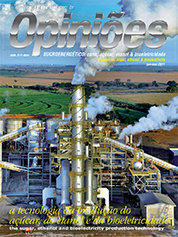Antonio Alberto Stuchi
Executive Industrial Director of Cosan Açúcar e Álcool
Op-AA-27
Fundamental pillars for success
Brazil’s success in the international sugar-based energy scenario is due to several factors, one of which is certainly the fact that the country has one of the best sugar and ethanol production technologies, with efficient cost levels that provide Brazilian products in this industry a high degree of competitiveness.
The sugar and ethanol production process, and more recently that of bioenergy, has a direct relation with three fundamental pillars. One is energy consumption. As many people know, an industrial plant in the sugar-based energy industry that processes sugarcane is self-sufficient in electric power consumption during harvesting, due to the fact that it burns bagasse in its boilers, generating the electric power needed to meet its needs.
The electric power generated from sugarcane bagasse has become a relevant product for companies in this industry. This practice directly contributes to offset the country’s energy shortage, allowing for supply even in periods when the rivers feeding hydroelectric plants are at their lowest levels. Furthermore, this energy greatly diminishes the distribution cost, due to the fact that the mills are close to consumption centers.
It is important to emphasize that this availability greatly depends on the reduction in consumption of energy used in the production process, which can be optimized in the existing mills or conceived with higher efficiency in new greenfield projects. Such optimization necessarily involves the more rational use of steam in processes, with the utilization of more efficient equipment that can operate at lower steam pressures, while using heat recuperated in different phases of the process, in which there are great differences in temperature among products.
The use of more efficient motorized equipment in this process is also important because it also allows making surplus electric power available for sale. Another feasible alternative to make use of all means of generating energy from sugarcane is to use straw, helping to economically consolidate the elimination of the burning process.
The availability of this energy in the mills actually represents a viable alternative for companies and governments. However, implementing this initiative depends on the investment necessary to expand the energy sourcing network in the production units and for distribution through the national consumption network. It is also important to stress that such investments must provide attractive returns to be viable.
On account of these factors, in our assessment, the industrial processes in the sugar-based energy industry have achieved highly efficient indices in terms of electric power consumption. This good performance positively affects two aspects: the first relates to production costs and the increase in competitiveness of products; the second relates to the availability of more electric power for sale to the public network, with both positively affecting the national economic scenario.
Another fundamental pillar related to productivity efficiency in our mills refers to industrial maintenance costs, that currently represent about 50% of the expenses of an industrial plant in the sugar-based energy industry – quite an expressive share. With respect to this aspect, in my opinion, what is needed is a cultural change, with the introduction of technologies that allow us to determine what level of intervention is required for each equipment, placing items that do not require maintenance in a hibernation process during the harvest off-season, typically quite long in our industry.
In line with this change, new materials and equipment must be developed and adapted to our processes to guarantee better performance and durability, thus increasing downtime intervals. Such increase in work efficiency will assure the reduction of costs necessary to maintain our competitiveness. Thus, maintenance work done properly in accordance with a well-structured plan may be the differential for achieving a good harvest, warranting that the industrial structure will perform as expected.
Lastly, the third pillar that guides our production process is co-existence with the environment. The sugar-based energy industry’s business model has a direct relation with environmental issues, given that ethanol is a viable energy matrix alternative that, when added to the existing alternatives, may effectively contribute to a low carbon economy.
Within the industry, we have positively progressed in several issues related to the subject matter, increasingly making our business model more mature and prepared for this new economy. It is important that the industry be increasingly more attent to issues related to decreasing the volume of vinasse and using it more rationally as a fertilizer, diminishing the use of water in production processes and adequately disposing of solid residues, which are all demands that will become more frequent in the industry.
The more representative elements in our industry are tuned to these extremely relevant and crucial matters, so that Brazil may occupy and consolidate a guaranteed space in the world economy. Even having attained historical achievements and a consolidated market, we are still faced with many challenges that need to be overcome. In our favor there is the concrete engagement of most companies in our industry, which are constantly discovering new solutions and becoming increasingly tuned to issues related to the environment, in which their solutions are transformed into models to be followed by others.




